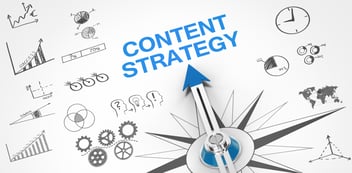6 Building Blocks For A Successful Digital Marketing Strategy
So it’s time to give you marketing a facelift, but where do you start?
Your company has a website, but it’s been years since you’ve updated it.
You have social media accounts established, but are they really working?
You’ve written blogs, but how many more can you write and are people even reading them?
The world of digital marketing is a vast and confusing landscape. With new platforms and formats for distributing content popping up every day, it is more important than ever to get your act together online.
Fortunately, you can create a marketing strategy that provides a solid ROI without pulling out your hair in the process. You just need the right tools (aka the Business GrowthStack) to get the job done.
What Is A Digital Marketing Strategy?
Before we get started, let’s define a digital marketing strategy. A digital marketing strategy is an action plan to help marketers deploy online marketing methods, platforms and content to reach your company's goals. Creating a targeted plan will help you leverage resources, optimize customer acquisition and ultimately see a return on your investment.
After the COVID-19 pandemic, most business owners now see the benefit of a digital marketing strategy. After all, there's no guarantee customers will happen to see your billboard or buy the magazine your ad is in. A digital marketing strategy guarantees that your brand is seen by your customers wherever they may be, whether they're on vacation or in their living room.
So what are the building blocks for a digital marketing strategy? Let’s take a look!
1. Conduct A Digital Asset Audit
If you have an online presence, then the first thing you need to do is conduct an audit of all your platforms. The digital audit has two very important components. The first includes an internal inventory of your current assets, including:
- Website
- Social media accounts
- Videos (live or yet to be posted)
- Email campaigns
- Offline marketing materials that supplement your digital efforts
If you have analytical information like HubSpot reports, collect that so you can evaluate the effectiveness of your content. This will also help you determine which channels/platforms will help you reach your individual goals.
The second piece of the digital audit includes a little research. During this phase, you will look at the digital competitive marketplace. What tactics are your competitors implementing and what baseline numbers can you establish as benchmarks? Follow your competitors' social media accounts and find out which types of posts perform the best for them, or watch their videos for inspiration.
You may feel like a creeper, but the purpose of a digital marketing strategy is to work smarter, not harder. If your competitors have something that works, you shouldn't reinvent the wheel. Follow their example while making the content entirely your own.
2. Define Your Goals
So you’ve scoped out the competition and taken inventory of all your assets. Now it’s time to define your business goals. Remember: If you don't know where you want to go, how can you possibly follow the right path to get there?
When setting goals, make sure you are creating SMART goals (Specific, Measurable, Attainable, Realistic, and Timely). For example, you may choose to increase traffic to your website by 5% over the next three months or increase your conversion rate by 2% over the next 6 months.
Make your goals specific, but also make them realistic. While we would all love a 500% increase in leads in just a month, it's probably not going to happen.
3. Develop Buyer Personas & Your BrandScript
We’ve all heard about buyer personas, and today they are more important than ever. A buyer persona is a semi-fictional character that outlines a company's ideal customer based on real data from current customers.
An in-depth persona includes but is not limited to demographics, pain points, consumer behavior patterns, motivations and goals. All of this information will help you tailor your message and determine what channels to spend the most time on.
Once you have identified your buyer persona, it's time to take that information and turn it into something practical. Donald Miller's StoryBrand Framework allows you to clarify your message and create content directed toward your specific buyer personas. Create a company BrandScript for your main persona based on the info you collect. Then use that BrandScript to create all of your content, from website page and emails to social media posts and video scripts.
Learn how to create buyer personas by downloading our Free Buyer Persona eBook, here

4. Remember Your Customer's Journey
The Buyer's Journey is something many business owners forget, but it's critical to keep the journey in mind when creating content for your brand. Customers will go through several stages during the purchasing decision. What steps are your customers taking to purchase your product? The more important the purchase, the more in-depth their journey may be.
Defining the purchasing journey will help you develop content around the different decision stages and help nurture customers down the sales funnel. You'll want to create strategic campaigns and marketing automation for each part of the buyer's journey. Remember to keep you messaging simple and outline a clear plan for potential purchasers.
5. Create A Channel And Content Strategy
By now, you know who your ideal customer is and what kind of journey they will be taking. Now it’s time to map out your content and determine which channels will help you spread your message effectively.
Consider demographic and behavior patterns here; for example, where do you customers hang out online? How do they research? Also consider what kind of information they will find most useful and create content around each stage of the sales funnel.
Here, we recommend the QuickStart process. This tried-and-true system provides your business with all the assets you need to implement the Business GrowthStack (as outlined in Steve Brown's book, The Golden Toilet). This would include:
- A user-friendly website that follows the StoryBrand Framework
- At least one strategic campaign (including a downloadable lead generating offer)
- Marketing automation in the form of a lead nurturing email series
- Sales automation in the form of a sales sequence
- A testimonial-generating campaign
6. Analyze And Adjust
The key to any effective campaign is the ability to measure its success. The type of data you focus on will depend on what type of goals you have set and the channel you are analyzing.
Luckily for us, there are many tools available to help track web traffic, lead sources, social media interactions, conversion rates and so much more. Monitoring data and even implementing A/B testing will help you determine the effectiveness of your strategy and identify pieces of your plan that need adjusting.
Taking on a digital marketing overhaul is no easy task! With so many channels and so much to do, it can be overwhelming.
If you're not sure where to start, request a Free Strategy Session with ROI Online. In just 30 minutes, you’ll walk away with a marketing game plan designed to help you grow your business and get better results from your marketing—no strings attached!
And if you haven't already, be sure to check out Steve's book, The Golden Toilet. Not only is it hilarious, but it also provides you with a deeper understanding of what marketing tactics work, which ones don't, and how you can get an ROI online.






